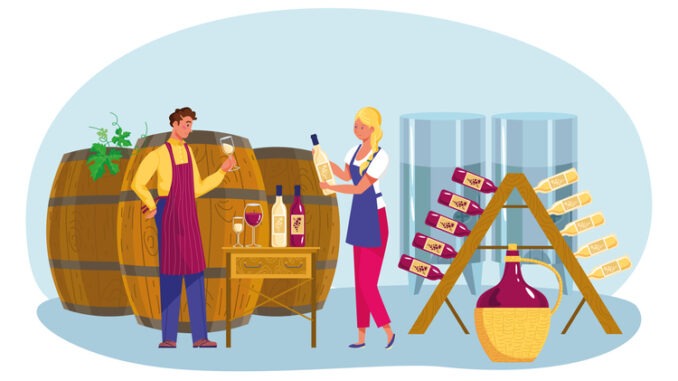
In part two of his series on winemakers and organisational leadership, David Carne, school business professional and executive coach, explores why both SBLs and winemakers have curiosity, creativity and time management in common
Read the full article below on page 16 in our January magazine
In part one of this article we looked at how, like winemakers growing vines, school leaders need to ensure that we match the context of our school, have deep character roots, create the conditions for success, continually maintain our organisations and are committed to serving our organisations for the long term. In this article, we’ll explore what we can learn from the actual process of winemaking.
It all starts with curiosity
Winemakers love wine. That is, perhaps, unsurprising, but they are also curious about wines. A good winemaker will taste other wines, learning about the styles, and the methods others used to create them. School leaders, too, must be curious; too often schools can become inward-looking and overlook the creativity and innovation that is going on in other institutions. Being curious involves accepting that there may be other, better, more innovative, ways of working and opens us up to possibility.
Creativity and calculated risk taking
I am very privileged to have developed a friendship with a winemaker, called Szilard, who lives in a small village in Hungary. Szilard is a great experimenter. Unlike, many of the other village winemakers, he likes to put his own innovative take on the wines he produces. He respects the history and terroir, but isn’t afraid to innovate for the future. He takes calculated risks.
This creativity, and willingness to take risks, is essential in school leadership. You can rarely ever know with 100% certainty the outcome of any given action – but sometimes you have to take it anyway. As leaders, we also need to provide a sense of safety for others to feel confident to take calculated risks, coaching them through their mistakes and failures; the alternative is an organisation too afraid to ever try anything new.
Getting the timing right
Another thing winemakers are experts at is getting the timing right. When do you pick the grapes to get the flavour you want in the wine? How long do you ferment the wine with its skins? How long do you continue to let the wine ferment after that – and how long do you age it in barrels to get the depth of flavour you are looking to achieve? The same is true of school leaders. You can try the right thing at the wrong time and fail – the strategy was right, but the people were not ready for it. Conversely, you can delay too long and not achieve the result you hoped for. We need to be able to read our organisations to know when to act.
Mixing and balancing
Good wine is not just about one thing, it is about the combination of hundreds of elements coming together in a balanced way. Winemakers balance acidity, sweetness, tannins, flavours, alcohol levels and may even bring two or more wines together to create a blend. School leadership is much the same. We want to get the right mix of staff, of initiatives, of communications to engage parents, investment in the right resources and training and development.
One of the great benefits of integrated curriculum financial planning is that it challenges us to consider this balance. School leaders need to be able to consider the needs of all pupil groups, build a balanced curriculum, bring together the right staff and know how to mix those ingredients in a way that means it is more than the sum of its parts.
More than just a numbers game
Winemakers, like school leaders, love measuring and evaluating what the numbers are telling them about their wine. The numbers matter, but you can still create a bottle of wine than has the numbers right yet tastes awful. As a school business leader numbers are a big part of my professional life; I’m a strong advocate for integrated curriculum financial planning, and benchmarking, and I am interested in the impact of our resource utilisation on outcomes. However, sometimes it is necessary to look beyond the numbers. You have to actually taste the wine and see if it is any good. In a school context, you have to check whether what you are doing is actually working for the pupils and the staff – and that means speaking to people, listening to what they are telling you and being open to constructive feedback. It also means having the humility to accept that you do not have all the answers, but the people around you may.
Not everyone will like what you do
When people learn that I have a bit of knowledge about wine they often ask what the best wine is. I tend to reply that, while there are technically brilliant wines, the best wine is the wine you like. Winemakers do what they do because they are passionate about their wines, the processes they have used, the varieties they work with and the styles they create. However, there will always be people who do not like their wine.
The same is true of leadership styles and organisations, and that is okay. We have to accept that education does not have a ‘one-size-fits-all’ approach, and people who do things differently are not somehow lesser or inferior. Comparing a Château Patris to a bottle of Cristal makes no sense – they are completely different styles of wine – but they are both good wines. It’s great to be passionate about what we do, to take great pride in it and to have confidence in it, but we do need to guard against arrogance and complacency.
As a leader, if people don’t like what you do, try not to take it personally.
Like the process of making wine, school leadership requires us to constantly maintain our curiosity, encourage creativity and calculated risk-taking, time things right, be able to balance complex needs and resources, look beyond the numbers and metrics and accept that not everyone is going to like our particular brand of organisation.


Be the first to comment